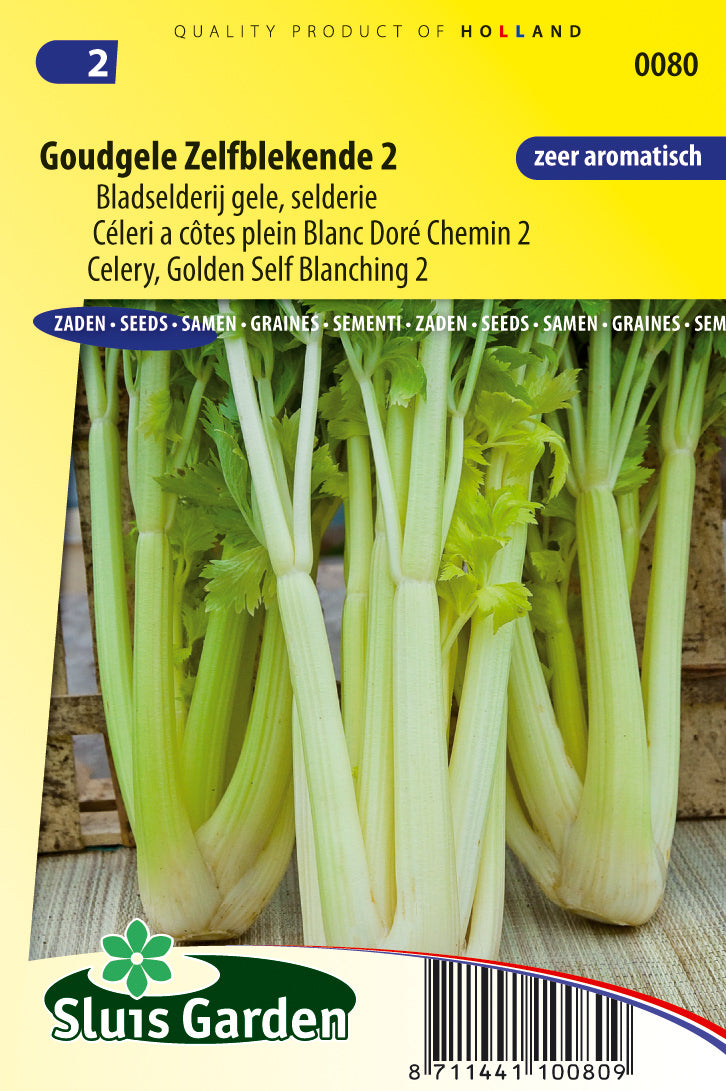1
/
of
1
Celery Golden Self Blanching 2
Celery Golden Self Blanching 2
Regular price
1.350 KWD
Regular price
Sale price
1.350 KWD
Unit price
/
per
Shipping calculated at checkout.
Couldn't load pickup availability
Growing Celery Golden Self Blanching 2 involves providing the right conditions for this specific celery variety. Here's a guide on how to grow Celery Golden Self Blanching 2:
**1. Planting Time:**
- Celery is a cool-season crop. Start seeds indoors 10-12 weeks before the last expected frost date in your area. Transplant the seedlings into the garden when they are 6-8 weeks old and the danger of frost has passed.
**2. Site Selection:**
- Choose a location with full sun or partial shade. Celery prefers well-draining soil rich in organic matter.
**3. Soil Preparation:**
- Amend the soil with compost or well-rotted manure to improve fertility and moisture retention. Celery prefers slightly acidic to neutral soil with a pH between 6.0 and 7.0.
**4. Planting Seeds:**
- Sow celery seeds indoors in seed trays or containers. Plant the seeds shallowly, as celery seeds require light to germinate. Transplant the seedlings into the garden when they are 4-6 inches tall.
**5. Watering:**
- Celery requires consistent moisture. Keep the soil evenly moist throughout the growing season. Celery has shallow roots, so it's crucial to avoid both drought stress and waterlogged conditions.
**6. Fertilization:**
- Fertilize the soil before planting with a balanced fertilizer. During the growing season, side-dress the celery plants with nitrogen-rich fertilizer every 3-4 weeks.
**7. Blanching:**
- "Self-blanching" varieties like Golden Self Blanching 2 are known for their ability to partially shade their own stalks. As the plants grow, you may want to tie the outer stalks together to encourage self-blanching and reduce bitterness.
**8. Companion Planting:**
- Celery benefits from being planted near plants like cabbage, leeks, and tomatoes. Avoid planting celery near strong-smelling herbs like dill.
**9. Pest Control:**
- Celery can be susceptible to pests like aphids and celery worms. Monitor your plants regularly and use insecticidal soap or neem oil for organic pest control.
**10. Harvesting:**
- Celery is ready for harvest when the stalks are about 8-12 inches tall and have reached the desired thickness. Harvest from the outside in, cutting stalks at the base of the plant.
**11. Culinary Uses:**
- Enjoy fresh celery in salads, soups, and snacks. Store excess celery in the refrigerator to maintain its crispness.
**12. Winter Care:**
- In colder climates, you can try protecting celery from frost by covering it with straw or other mulching materials.
Adjust these guidelines based on your local climate and growing conditions. Celery Golden Self Blanching 2 is known for its mild flavor and crisp texture, making it a popular choice among gardeners.
**1. Planting Time:**
- Celery is a cool-season crop. Start seeds indoors 10-12 weeks before the last expected frost date in your area. Transplant the seedlings into the garden when they are 6-8 weeks old and the danger of frost has passed.
**2. Site Selection:**
- Choose a location with full sun or partial shade. Celery prefers well-draining soil rich in organic matter.
**3. Soil Preparation:**
- Amend the soil with compost or well-rotted manure to improve fertility and moisture retention. Celery prefers slightly acidic to neutral soil with a pH between 6.0 and 7.0.
**4. Planting Seeds:**
- Sow celery seeds indoors in seed trays or containers. Plant the seeds shallowly, as celery seeds require light to germinate. Transplant the seedlings into the garden when they are 4-6 inches tall.
**5. Watering:**
- Celery requires consistent moisture. Keep the soil evenly moist throughout the growing season. Celery has shallow roots, so it's crucial to avoid both drought stress and waterlogged conditions.
**6. Fertilization:**
- Fertilize the soil before planting with a balanced fertilizer. During the growing season, side-dress the celery plants with nitrogen-rich fertilizer every 3-4 weeks.
**7. Blanching:**
- "Self-blanching" varieties like Golden Self Blanching 2 are known for their ability to partially shade their own stalks. As the plants grow, you may want to tie the outer stalks together to encourage self-blanching and reduce bitterness.
**8. Companion Planting:**
- Celery benefits from being planted near plants like cabbage, leeks, and tomatoes. Avoid planting celery near strong-smelling herbs like dill.
**9. Pest Control:**
- Celery can be susceptible to pests like aphids and celery worms. Monitor your plants regularly and use insecticidal soap or neem oil for organic pest control.
**10. Harvesting:**
- Celery is ready for harvest when the stalks are about 8-12 inches tall and have reached the desired thickness. Harvest from the outside in, cutting stalks at the base of the plant.
**11. Culinary Uses:**
- Enjoy fresh celery in salads, soups, and snacks. Store excess celery in the refrigerator to maintain its crispness.
**12. Winter Care:**
- In colder climates, you can try protecting celery from frost by covering it with straw or other mulching materials.
Adjust these guidelines based on your local climate and growing conditions. Celery Golden Self Blanching 2 is known for its mild flavor and crisp texture, making it a popular choice among gardeners.
Share

